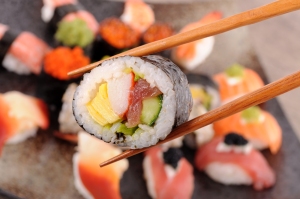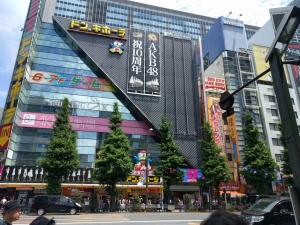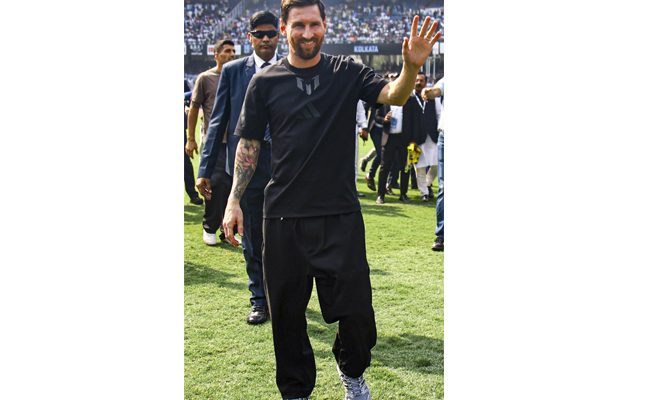Japan, June 25: I know I haven’t blogged for a long time, I successfully came to Ritsumeikan University and became a part of Sakura Student Exchange Program. In this blog post, I want to share my journey from India to Japan and back. My 8 days expedition of Japan was very cinematic.
The Japan-Asia Youth Exchange program in Science also known as SAKURA Exchange Program in Science is a program administered and conducted by Japan Science & Technology Agency (JST). Ritsumeikan University, Japan was the host for the program held from June 13 to June 20 with a theme of Drone Technology. It is a matter of great pride that I got to be a part of the program.
First flight experience is unforgettable for any one. I still remember everything in minute detail, it seems like yesterday I boarded flight in Bangalore. Time flies very fast.
PEOPLE AND CULTURE

From what I’ve seen, Japanese people want to keep the world in at least as good of a state as when they found it. Take, for example, a plant growing next to a sidewalk. In India, someone is going to walk by, see the plant, and decide they want to stomp on it. In Japan, that little plant is going to flourish. This doesn’t just apply to plants, but also to fixtures on the sides of buildings, signs, walls that stay clean and much more.
People tend to avoid being the center of attention. It is rare that someone makes a loud noise, makes a “scene” in a public place. This is sharply contrasted with India where people like to ride public transit while blasting loud music or scream at other passengers.
For the most part you won’t get unsolicited advice while wandering around Japan. Perhaps if you’re looking really confused and standing in the same spot for 10 minutes someone will come help. That said, if you ask for help, language barriers aside, you will receive it.
Kids go everywhere by themselves. Japan is so safe that families have a tradition of getting their children out and about by themselves doing stuff as young as 5 years old. It’s nothing to see young kids 6, 7 years old riding the subways alone to go to school.
THE ATTIRE
There are many awesome things you can do in Japan that you can’t do in other countries and the important one is being dressed in a Kimono or a Yukata. Kimono and Yukata are traditional Japanese garments that have charmed people around the world with their beauty, style, and traditional aesthetic. We were lucky to get an opportunity to wear the Yukata. It feels like true Japanese when we put on those wonderful apparels.

AUTHENTIC JAPANESE CUISINE
Japan is one of the best culinary countries in the world! Although it is a small country compared to many other countries in the world, but every region and island has its own specialty when it comes to food. Most restaurants in Japan are specialty restaurants, specializing in one dish or one type of cuisine.
Some Japanese Food Dishes You Must Try
1. RAMEN
You will find Ramen basically all over Japan, on almost every street corner. It is a wheat noodle soup dish that was originally imported from China. Ramen are eaten with chopsticks, and as the noodles get soggy pretty quickly you should eat them immediately after they are served.

2. SUSHI
Sushi is raw fish and seafood packed together with rice and vegetables into beautiful pieces. Each little piece is almost like an art!
Although I did not like the taste, it is worth the try in the land of Sushi.

3. TEMPURA
Japan can thank the Portuguese for Tempura, as it was Jesuit missionaries in Nagaski who first introduced Japan to the art of batter frying. Tempura is chunks of seafood and vegetables dipped in a light batter and cooked in canola and sesame oil. It is normally eaten together with a bowl of rice.
Japan really surprised us with its cuisine; it is very tasty and healthy with a great variety. They really put their pride into their cooking and their food, and it is all very clean as hygiene is very important in Japan. Japan has food for everybody, whether you like seafood, raw food, strange meat, vegetables or noodles….they have it all!

BUILDINGS
1. TEMPLES / SHRINES

Whenever you go to a Temple you’re expected to leave your shoes outside. Some temples provide you with bags you can carry your shoes in, some have lockers, and others just have a large shoe orgy on the front entrance. Orange paint was believed to keep evil spirits away, which is why many of the temples and gates are painted in bright orange. Admission is usually free, with areas where you can donate.
2. MEGA MALLS

There are many massive “Malls” throughout Japan, following the same pattern of being about eight floors tall. One of the floors will be dedicated to mobile phones, another to model building, photography, video gaming, comics, household appliances, and food. Most of the malls are twice or even thrice the size of Indian Malls.
3. AUTOMATED TOILETS

An electronic Japanese toilet has a bidet built in, a device which cleans your ass by spraying water into it. The toilet has a complex control panel, with bidet options for weak, strong, and a special woman-only option. The toilet is also heated, and can play noises. You might have a tough time learning the functions of all the buttons like we did. But trust me you will enjoy this once you figure out the working of it.
TRANSPORTATION
Just as the world loves its cars like Toyota and Mitsubishi, there are some great driving habits of Japanese people that are worth learning too.
Considering the fact that every country has different traffic and driving rules, one cannot apply the rules of one country in another. However, there are certain habits that make for the best habits ever, irrespective of whether they are a part of the rules.
No one honks in Japan. Honking is considered rude in Japan. It’s even considered as aggressive. Instead, drivers are very courteous. They let other drivers in front of them.
Almost no one moves in Japan unless a green light tells them to.
TRAINS

The trains here are amazing. Unlike India, they don’t make horrible high pitched screams, they aren’t covered in hobo urine, they are on time, and if they are not the management makes sure that an alternate train is arranged to avoid wasting time of the passengers. The trains even have racks above the seating areas where one can leave their bags. In India, your bags would disappear if left on one of these racks. Unlike India people form lines to enter and exit the trains and not rush at the entrance.
SHINKANSEN (新幹線)

The Shinkansen is a Bullet Train which we took from the Maibara Train Station to Kyoto. Maibara train station is the place to stand and photograph as they pass in the blink of an eye. This may not sound exciting, but trust me, it is quite an experience. This train travels very fast and it took 19-minute for us to reach Kyoto Station. It clocked speeds up to 275 kmph. Purchasing tickets for the Shinkansen is very similar to purchasing tickets for an airplane, minus all the painful security checks. They do cost a surprising amount though, not affordable for a daily trip. That said, they are effectively the same as taking an airplane.

THE SOUVENIRS
When it comes to Japanese souvenirs the list is endless, really! From everything Pokémon and Hello Kitty to electronics and unique beauty products, Japan has something for everyone.
1. KIT KAT

Kit Kats sold in Japan come in several unique flavours – setting them apart from the Kit Kats of other countries. In fact, most of these flavours are only available in Japan.
2. FOLDING FANS

Folding fans or “sensu” are usually made of bamboo or Japanese cyprus then connected by washi paper. They come in a lot of designs and are worth gifting.
3. JAPANESE MANGA AND ANIME
Walking into a Japanese bookstore, you might understandably be mistaken to think that all books are Japanese comics. Their covers are full of adorable illustrations. But alas, manga are their very own specific section and these sections are as big as a book stores in India. We bought “Death Note”, “Naruto” , “Dragon Ball-Z” and much more.

I am in love with Japan. Everything about it seems awesome. The place and the people are so wonderful that anyone who visits and discovers the place would crave to stay longer and some might even want to stay forever just like what we felt.
This was first published in writer's blog https://rahulrpai.wordpress.com. Rahul Pai is pursuing Mechanical Engineering at NMAMIT, Nitte and visited Japan recently as part of Sakura Student Exchange Program .
Let the Truth be known. If you read VB and like VB, please be a VB Supporter and Help us deliver the Truth to one and all.
Mumbai (PTI): In view of Argentine superstar footballer Lionel Messi's visit to Mumbai on Sunday, the city police are implementing stringent security measures, like not allowing water bottles, metals, coins inside the stadiums and setting up watchtowers to keep an eye on the crowd, officials said.
The police also said taking extra care to avoid any stampede-like situation and to prevent recurrence of the chaotic situation that unfolded in Kolkata during Messi's visit on Saturday as thousands of fans protested inside the Salt Lake stadium here after failing to catch a clear glimpse of the football icon despite paying hefty sums for tickets.
Messi is expected to be present at the Cricket Club of India (Brabourne Stadium) in Mumbai on Sunday for a Padel GOAT Cup event followed by attending a celebrity football match. He is expected to proceed to the Wankhede Stadium for the GOAT India Tour main event around 5 pm.
"In view of Lionel Messi's visit to Mumbai, the police are geared up and have put in place a high level of security arrangements in and around the stadiums located in south Mumbai. Considering the chaos that prevailed in Kolkata and the security breach, we have deployed World Cup-level security arrangements at Brabourne and Wankhede stadiums," an official said.
Expecting heavy crowd near the stadiums during Messi's visit, the city police force has deployed more than 2,000 of its personnel near and around both the venues, he said.
As the Mumbai police have the experience of security 'bandobast' during the victory parade of ICC World Cup-winning Indian team and World Cup final match at the Wankhede Stadium, in which over one lakh cricket fans had gathered, we are prepared to handle a large crowd of fans, he said.
"We are trying to avoid the errors that occurred in the past," the official said.
There is no place to sneak inside the stadiums in Mumbai like the Kolkata stadium, according to him.
The police are also asking the organisers to provide all the required facilities to the fans inside the stadium, so that there will be no chaos, he said, adding the spectators have purchased tickets in the range of Rs 5,000 to 25,000. After paying so much of amount, any spectator expects proper services, while enjoying the event, he said.
The police are expecting 33,000 spectators at the Wankhede Stadium and over 4,000 at Brabourne Stadium. Besides this, more than 30,000 people are expected outside and around the stadiums just to have a glimpse of the football sensation, he said.
The organisers responsible for Messi's India visit recently came to Mumbai to discuss security arrangements. During the meeting, the Mumbai police asked them not to take the event lightly, according to the official.
After those requirements were fulfilled, the final security deployment was chalked out, he said.
Police has the standard procedure of the security arrangements inside the Wankhede Stadium, where people are barred from taking water bottles, metals objects, coins. Police are setting up watch towers near the stadiums and there will be traffic diversions, so that there is maximum space available to stand, according to the official.
Police are also appealing to the spectators to use public transport service for commuting and avoid personal vehicles to reach south Mumbai.
To avoid any stampede-like situation, police are also taking precautionary measures and will stop the fans some distance ahead of the stadium and public announcement systems will be used to guide the crowd. Barricades will be placed at various places to manage the crowd.
In case the crowd swells up beyond expectation, the police will divert people to other grounds and preparations in this regard underway, he said.
Additional police force has been deployed in south Mumbai to tackle any kind of situation, he said.





